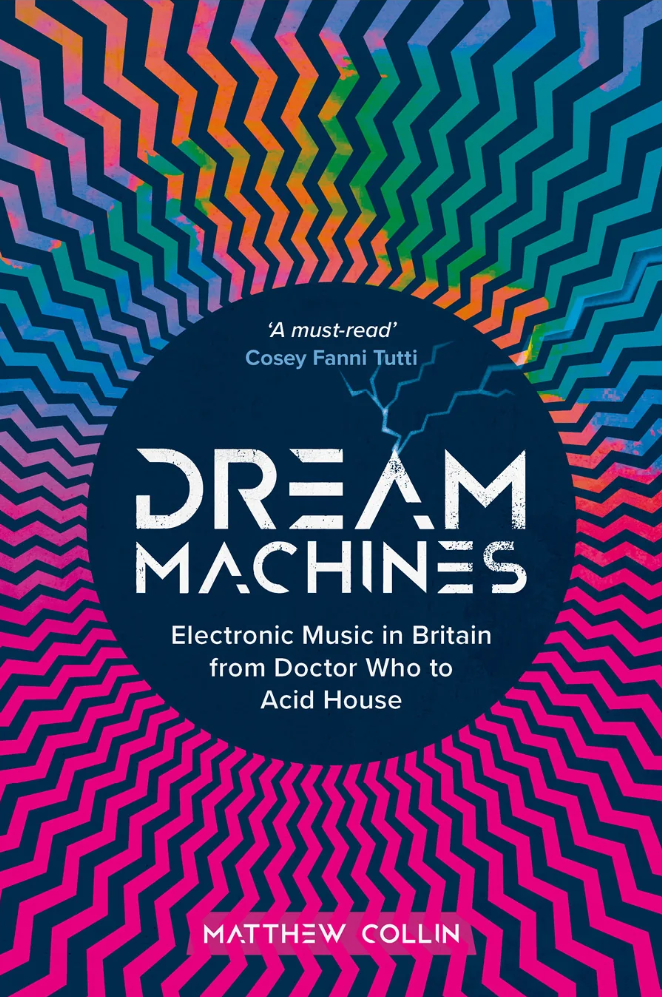
MATTHEW COLLIN -Dream Machines: Electronic Music in Britain from Doctor Who to Acid House
- by J.N.
- Posted on 15-05-2024
BAND URL: https://omnibuspress.com/collections/frontpage/products/dream-machines-electronic-music-in-britain-from-doctor-who-to-acid-house
Dream Machines by author Matthew Collin is quite literally a dream come true for anyone interested in the subject of British electronic music – regardless of whether one is merely curious about the phenomenon or harbor much more than just a passing interest in its gloriously labyrinthine history.
Exhaustively researched, elegantly written, and remarkably cohesive and easy to digest, its 416 pages guide us through decades of electronic sounds with a sense of vigor and zeal, and every memorable page is positively brimming with passion. With his keen eye for quirky details and entertaining trivia not to mention an impressive knack for highlighting the most vital and essential aspects of every artist and band’s relation to the diverse and chimerical nature of electronic music, Collin has composed nothing less than an outstanding and utterly engrossing account of the birth, development, influence, and cultural impact of the genre, or rather genres as we move seamlessly from musique concrete, space rock, prog rock, ambient, and art rock to synth pop, electro, new wave, post-punk, trip hop, noise, industrial rock and then further on to hip hop, hi-NRG, techno, and dub (just to list some examples). There are also fascinating sections detailing the significance of stereo sound systems in the seventies and early eighties, how sample mania became a thing of controversy, the allure of the New Romantics movement, and the pulsating intensity and appeal of rave parties.
The chapters chronicling the influence and importance of the Radiophonic Workshop form a spellbinding examination of the looming potential and promise of electronic sound collages in that this remarkable group of individuals showed early signs of where avantgarde music might be heading in the decades to come. Their complete disregard for what was commonly known to constitute “proper” music entailed that their artistic endeavors truly pushed the envelope of what was possible to achieve with respect to crafting otherworldly soundscapes by unconventional means – soundscapes that offered a sense of perfect escapism but also inspired others to approach and perceive music differently. Other highlights include entries on Gong, Tangerine Dream, Pink Floyd, Roxy Music, David Bowie, Brian Eno, Cabaret Voltaire, Throbbing Gristle, Hawkwind, Joy Division, and The Human League.
A rather inspiring and engaging aspect of Dream Machines is its focus on the pioneering spirit of the mavericks and innovators who toiled away in the shadows, often recording their experiments under less-than-ideal circumstances, using whatever primitive equipment and tools were at hand. Acts such as New Order, Depeche Mode, Soft Cell, and Pet Shop Boys obviously brought electronic music to the masses, thereby ensuring that it reached a wider audience and became more ingrained in the cultural fabric of the day, but the underground scene was arguably even more vital, creatively speaking, in that it was consistently bursting with brand-new and sparkling ideas that propelled the various strands of electronic music forward.
The many different life stories that have been woven into the larger narrative are captivating, and the wildly enthusiastic and inquisitive way in which they are discussed and brought to the forefront makes Dream Machines an essential read that throws up many delightful surprises but ultimately also raises questions about the very essence of music and its seemingly elusive and fluid state of being. The entire story is a passionate, audacious, and intoxicating renewal of the nature of writing about British electronic music and its repercussions, and it is bound to challenge our perceptions about music. Listen closely to the multitude of scintillating voices and the eclectic cast of characters that inhabit this meticulously researched tome; their tales and anecdotes make for an unforgettable reading experience.
